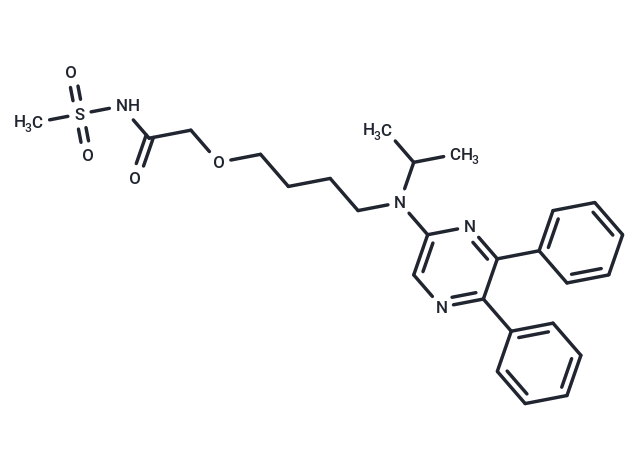Shopping Cart
Remove All Your shopping cart is currently empty
Your shopping cart is currently empty
Selexipag (ACT-293987)(NS-304) is prostacyclin receptor agonist that causes vasodilation in pulmonary vasculature and is used in the therapy of pulmonary arterial hypertension (PAH).

| Pack Size | Price | USA Warehouse | Global Warehouse | Quantity |
|---|---|---|---|---|
| 5 mg | $42 | In Stock | In Stock | |
| 10 mg | $58 | In Stock | In Stock | |
| 25 mg | $84 | In Stock | In Stock | |
| 50 mg | $97 | In Stock | In Stock | |
| 1 mL x 10 mM (in DMSO) | $46 | In Stock | In Stock |
| Description | Selexipag (ACT-293987)(NS-304) is prostacyclin receptor agonist that causes vasodilation in pulmonary vasculature and is used in the therapy of pulmonary arterial hypertension (PAH). |
| Targets&IC50 | IP (human):260 nM (Ki) |
| In vitro | Selexipag is an orally available and long-acting IP receptor agonist prodrug, and its active form, MRE-269, is highly selective for the IP receptor. Selexipag inhibits the binding of [3H]Iloprost to the human and rat IP receptors in a concentration-dependent manner. The Ki is 260 nM for the human IP receptor and 2100 nM for the rat IP receptor. The intracellular cAMP levels in hIP-CHO cells are increased in a concentration-dependent manner by treatment with Selexipag with EC50 of 177 nM. Selexipag also inhibits platelet aggregation in humans and monkeys with IC50 values of 5.5 and 3.4 μM, respectively, but it shows no inhibition in dogs (IC50 of >100 μM)[1]. |
| In vivo | The Cmax of MRE-269 after oral administration of Selexipag is 1.1 μg/mL in rats and 9.0 μg/mL in dogs. Selexipag at 1 or 3 mg/kg increases FSBF in anesthetized rats for more than 4 h after intraduodenal administration in a dose-dependent manner. In particular, Selexipag at 3 mg/kg causes a sustained increase in FSBF and exhibits a maximal increase of 93% in FSBF 1 h after administration[1]. |
| Cell Research | NS-304 is dissolved in DMSO and stored, and then diluted with appropriate medium before use[1]. CHO cells expressing the human IP receptor (hIP-CHO cells) are seeded at 1×105 cells/well in a 24-well plate and cultured for 48 h. The cells are washed with Dulbecco's phosphate-buffered saline without divalent cations, preincubated in the medium for 1 h at 37°C, and then incubated for 15 min at 37°C with medium containing each drug in the presence of 500 μM 3-isobutyl-1-methylxanthine. The medium is removed, and perchloric acid solution is added to terminate the reaction. Intracellular cAMP levels are measured by enzymelinked immunosorbent assay[1]. |
| Synonyms | Uptravi, NS-304, ACT-293987 |
| Molecular Weight | 496.62 |
| Formula | C26H32N4O4S |
| Cas No. | 475086-01-2 |
| Smiles | N(CCCCOCC(NS(C)(=O)=O)=O)(C(C)C)C=1N=C(C(=NC1)C2=CC=CC=C2)C3=CC=CC=C3 |
| Relative Density. | 1.210 g/cm3 (Predicted) |
| Color | White |
| Appearance | Solid |
| Storage | Powder: -20°C for 3 years | In solvent: -80°C for 1 year | Shipping with blue ice/Shipping at ambient temperature. | |||||||||||||||||||||||||
| Solubility Information | DMSO: 15 mg/mL (30.2 mM), Sonication is recommended. | |||||||||||||||||||||||||
| In Vivo Formulation | 10% DMSO+40% PEG300+5% Tween 80+45% Saline: 2 mg/mL (4.03 mM), Sonication is recommended. Please add the solvents sequentially, clarifying the solution as much as possible before adding the next one. Dissolve by heating and/or sonication if necessary. Working solution is recommended to be prepared and used immediately. The formulation provided above is for reference purposes only. In vivo formulations may vary and should be modified based on specific experimental conditions. | |||||||||||||||||||||||||
Solution Preparation Table | ||||||||||||||||||||||||||
DMSO
| ||||||||||||||||||||||||||
| Size | Quantity | Unit Price | Amount | Operation |
|---|

Copyright © 2015-2025 TargetMol Chemicals Inc. All Rights Reserved.